Once upon a time, there was a hadrosaur that was believed to have had a head crest that resembled that of the mythical unicorn. So unique was this head crest that it was affectionately dubbed the unicorn dinosaur and would be a source of inspiration for countless artist worldwide for decades.
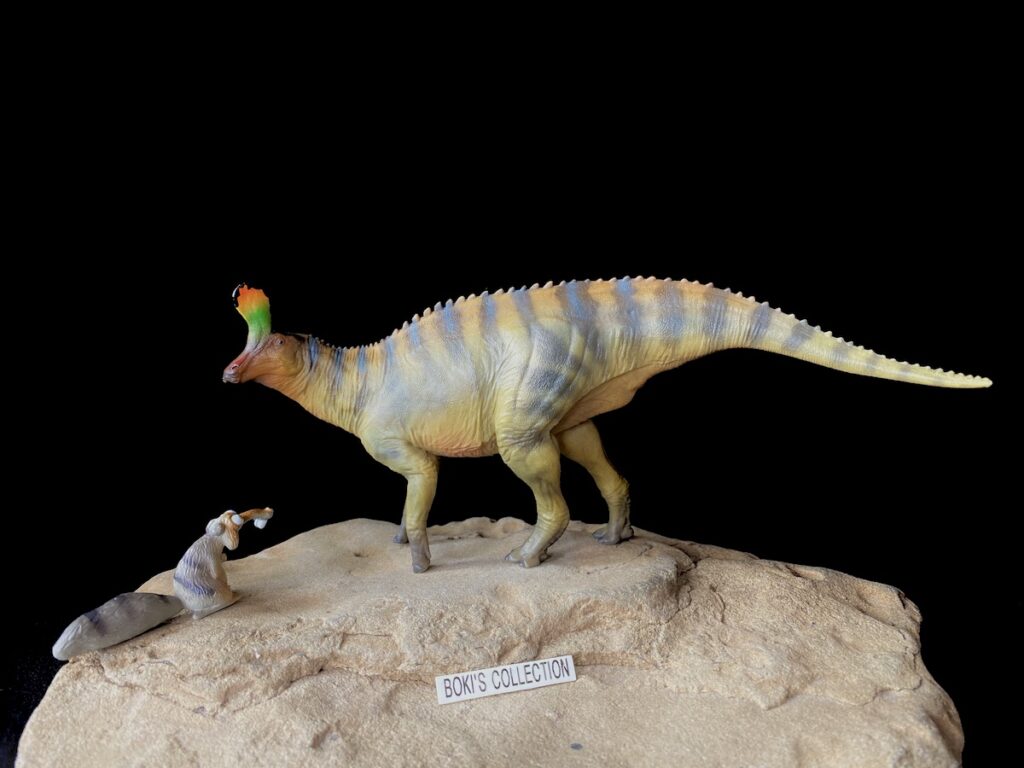
Tsintaosaurus meaning “Quindao lizard with a nose spine” (Tsintaosaurus spinorhino) is a genus of hadrosaurid dinosaur from China that was first described way back in 1958. It hails from the Jingankou Formation which was part of the Wangshi Group dating from the Cretaceous Campanian. Here, several bones have been recovered which included what would be assigned to Tsintaosaurus. Among the bones associated to Tsitaosaurus were a partial skeleton which included a skull and the crest. The crest, consists of a long bone that protruded at an almost vertical orientation at the top of the rear snout and seems to be hollow with what appears to be a small forked upper end.Thus, the image of this unicorn-like hadrosaur was born as artist and scientist reconstructed it showing a single horn-like crest at the top of its head.


I have to admit that I was not aware of this genus until CollectA introduced one into their collection more than a decade ago. And what a way to introduce this enigmatic dinosaur to the world! CollectA is known for their dedication to spotlighting obscure dinosaur so it was not surprising that they would be the first. What was surprising is how they chose to reconstruct that famous head crest. I’m sure that like many, your first reaction when you saw images of the model was ” No! No they did not really just do that to the crest, did they?”. For there it was, the Tisntaosaurus head crest in all its “glory”! Once you see it you can never unsee it! Looks like the good folks at CollectA at least have a good sense of humor!
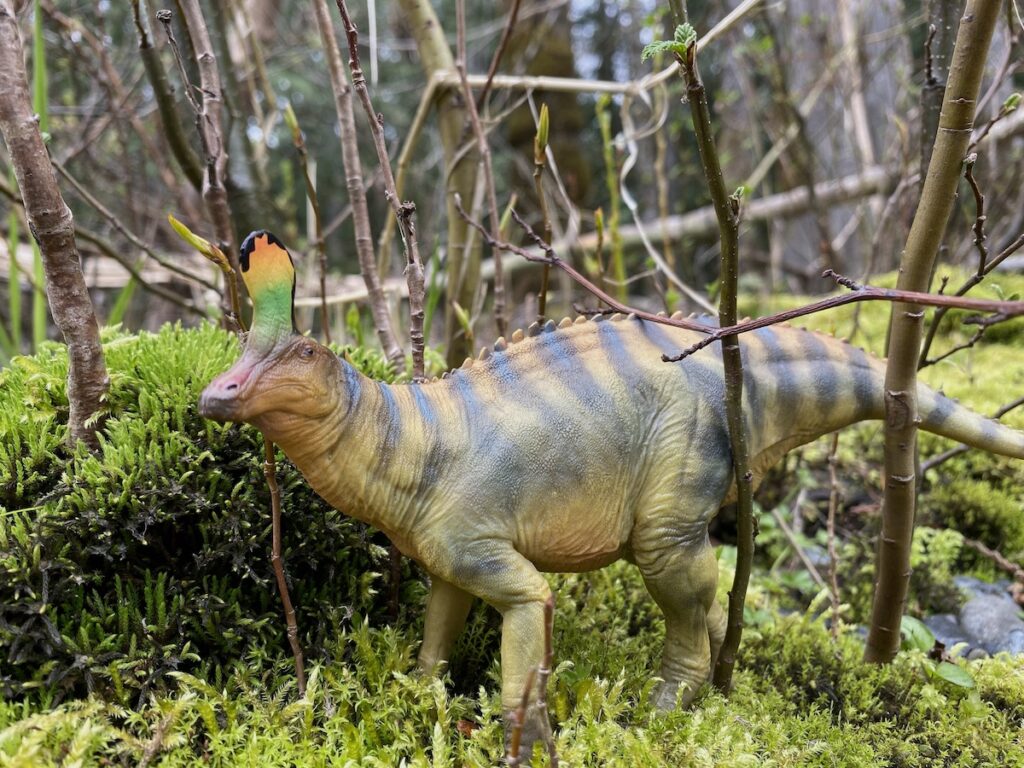
Despite its unique head crest, when compared to those of other hadrosaurs, it’s not as flamboyant which may have affected its potential in the toy market world forTsintaosaurs figure model would remain a rarity with just a handful, and two of them happens to be from PNSO. Today, we take a look at this exquisite new model of Tsintaosaurus from PNSO, part of their expanding Museum Line series and released this year. As mentioned, this is not the first version from them, earlier we saw a pricey resin model from couple of years ago as well as a small PVC one from the mini line, oh and let’s not forget that image of a model leisurely resting (which never saw the light of day and remained an illusion). All of these models have one thing in common that this new model doesn’t share : they all show the animal with a unicorn-like crest.

After enjoying the distinction of being the oddball duckbill unicorn dinosaur for decades, a new study in 2013 would shatter this image. The study concluded that the crest, as originally found, was actually part of a larger crest, more specifically the rear part. And just like that, the unicorn image of Tsintaosaurus was shattered and forever changed. The new crest restoration would put it closer to the typical shape we see in other hadrosaurs.
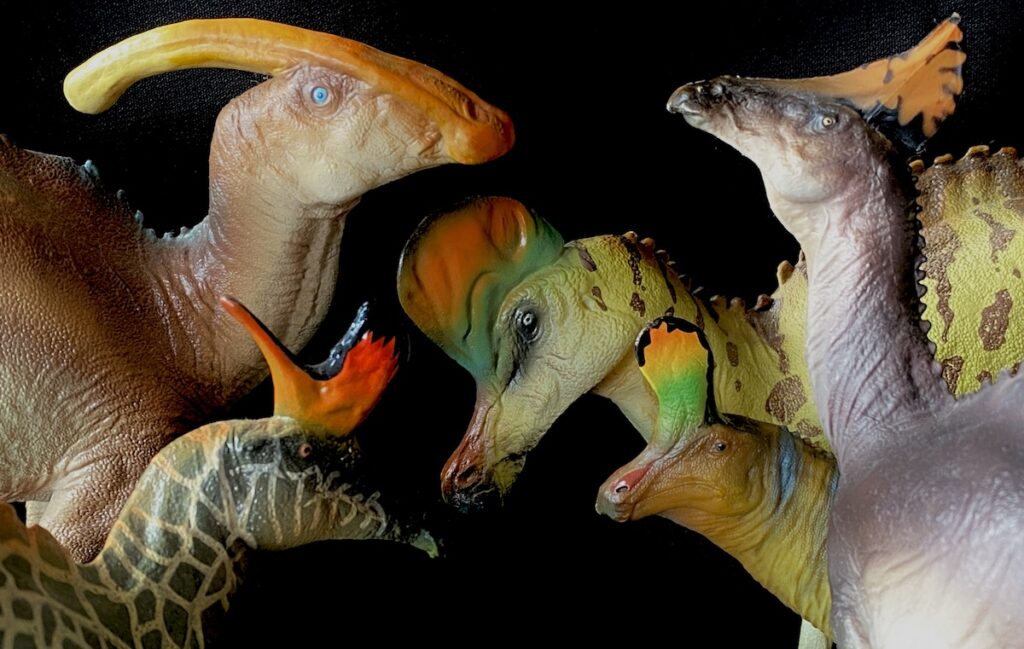
What would emerge is a crest that seems to be a mixture of a lot of the standard hadrosaur crest: wide at the base like that of Parasaurolophus, then widen as it rises but not as much as the helmet shape seen in Corythosaurus, then forms a bulbous shape at the top that is more rounded than the fan shaped seen in Olorotitan. Although not as romantic as the unicorn shape, this new crest restoration is still very unique and eye-catching. This is what the crest shape we see in this new model.

PNSO released a quartet of beautiful hadrosaurs (Lambeosaurus, Corythosaurus, Parasaurolophus, Olorotitan and of course the Iguanodon) before this model and its wonderful that they continue to do so. Joining the elite Museum Line club, meet Xiaoquin the Tsintaosaurus! He is certainly worthy of this membership even though it may seem counter intuitive to add what is often considered an obscure dinosaur, let alone a herbivore to this exclusive club. Although Tsintaosaurus may not have a broad name recognition outside of China, in its country of origin, it is one of the most popular dinosaur.
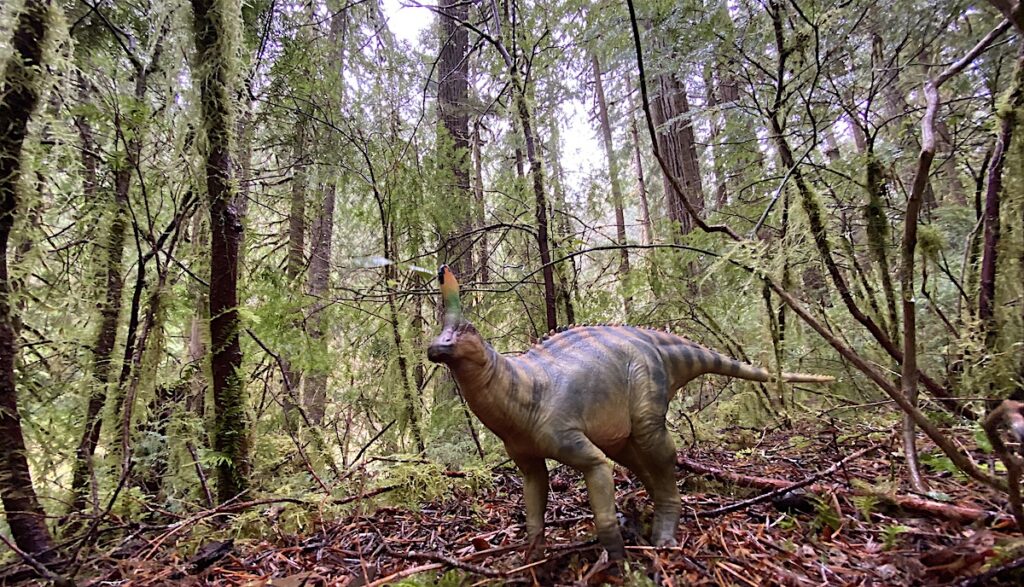
Size wise, Tsintaosaurus attained a good size with an estimated length of around 33′ feet. Like many PNSO model, it is also billed as 1:35 scale. The model measures 8.5” inches long and 3.75” inches tall (at the crest), if considered as a 1;35 scale, then it would appear to be based on a smaller individual of around 25’ feet, if you base it on the largest size estimate of 33′ feet, then the model fit in roughly around the 1:37-1:45 scale. It is its smaller size that has received the most negative reaction from those who had purchased it. Yes, the size discrepancy between it and the other PNSO hadrosaurs when seen side-by-side is startling as each of them dwarf it! It is closest in size to the Lambeosaurus and Olorotitan.

Looking at the head, we see the latest crest reconstruction beautifully replicated in the model. It would start to sound redundant to go over each of the detail again, but suffice to say that the head is full of all exquisite details that PNSO has become known for. The crest itself is so strikingly painted with a color combination of Green,Orange, yellow, and red, all bright and framed by black outline that further calls attention to it.
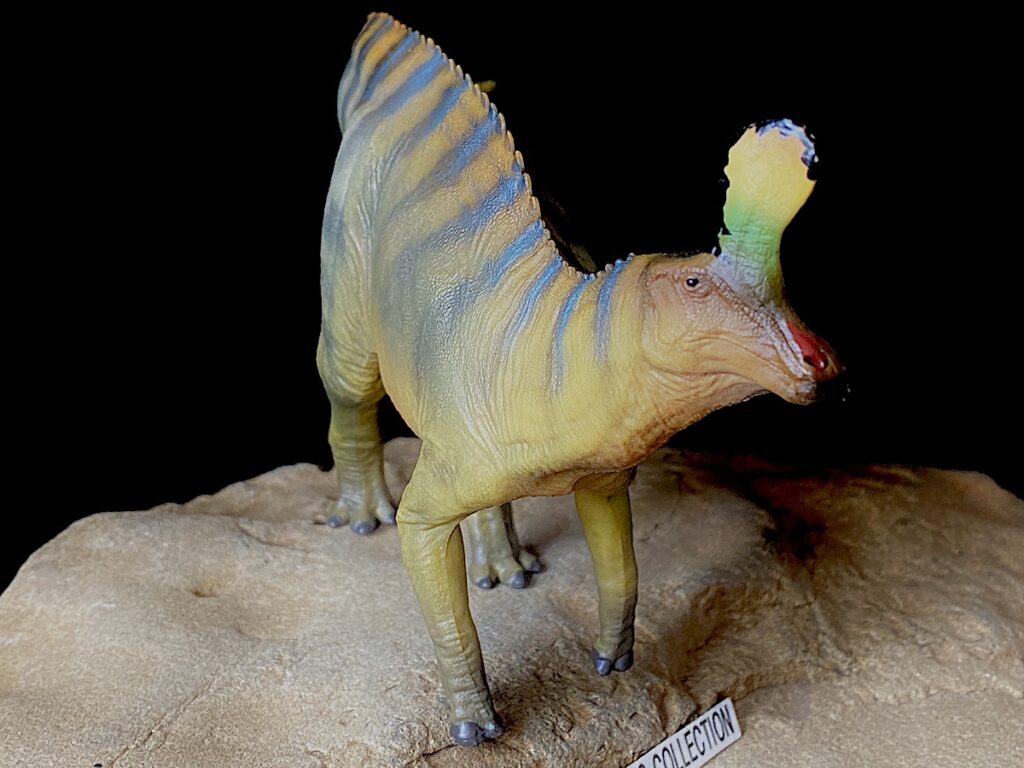
The blending and transition of these crest color is so seamlessly done; the only thing that does not live up is the black outline which from the look of it was hand painted. Compared to the other colors, it looks too thick and artificial and leaves a sharp lines. There is a red color used on the nostrils and top of the snout that is a nice contrast to the darker colors just below the jaw.
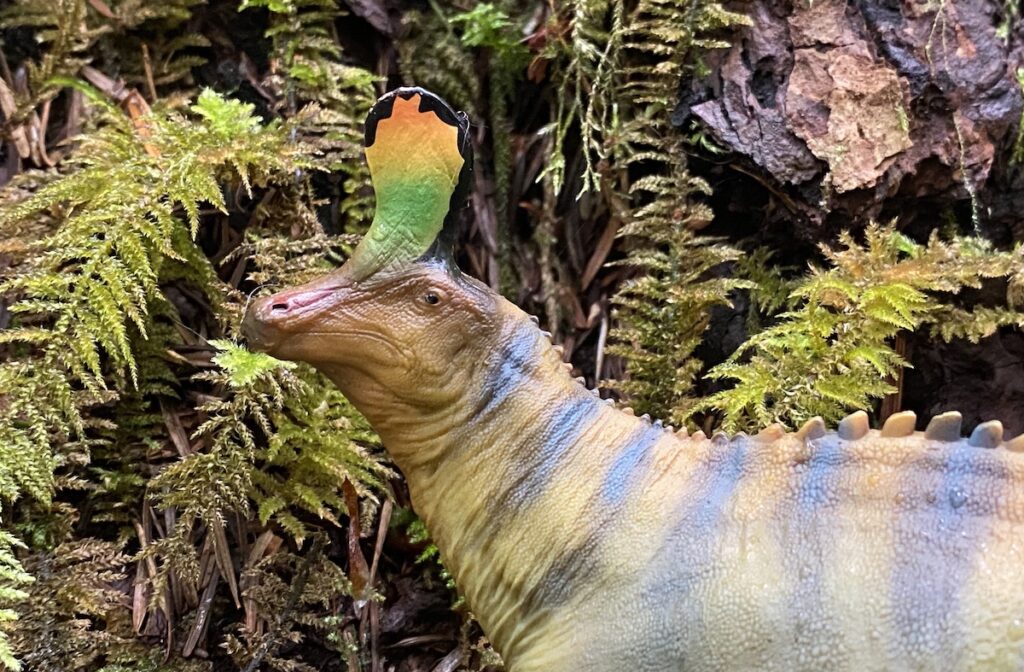
The details on the snout are sharp and show beautiful curvature as the flesh follow the bone structure of the skull. The eyes is small and painted black with no paint bleeding. In recent years there has been a lot of new study and proposal regarding the neck of hadrosaurs, especially the skin and musculature that cover it. We have been used to seeing hadrosaurs with long and graceful swan-like necks, we see these in the earlier PNSO hadrosaurs. These image is now being replaced with a neck that is more robust and covered in heavy muscle. Finally, we see this robust neck for the first time in a toy hadrosaur in this model.

And what an impressive neck it is! This robust reconstruction makes the neck look shorter at first glance. But the skin of course is flexible so the animal is able to move and stretch it. We see a neck that is strong and muscular with lots of folds and wrinkles. It really is wonderful to see this in a model and stands out from others. This neck reconstruction is just one of several key features that reflects some of the most current and up-to-date understanding of hadrosaurs seen in this model.
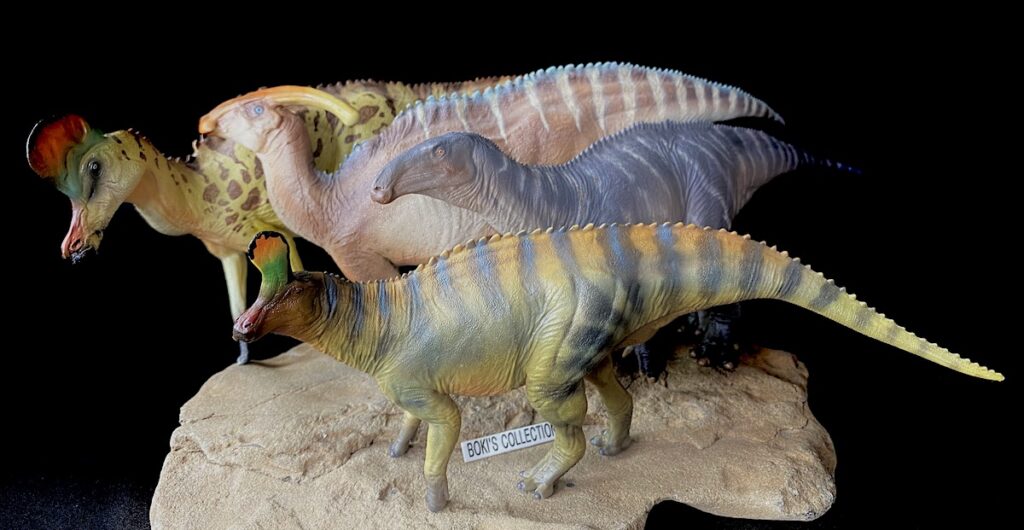
On the back you can see a single row of dorsal spines sculpted individually running all the way down the main body until it reaches the tip of the tail. The tail base is generously muscled and one can see even the tendon outlines that really captures the great power it has.The body itself is robust and showcase the typical exquisite details. The figure is posed on all four legs on the ground. The head and neck is slightly turned to one side as if the animal is looking back, the tail also has a slight curve to it that suggest movement and is slightly oriented downwards. Overall, these subtle turns gives the figure a good sense of movement.
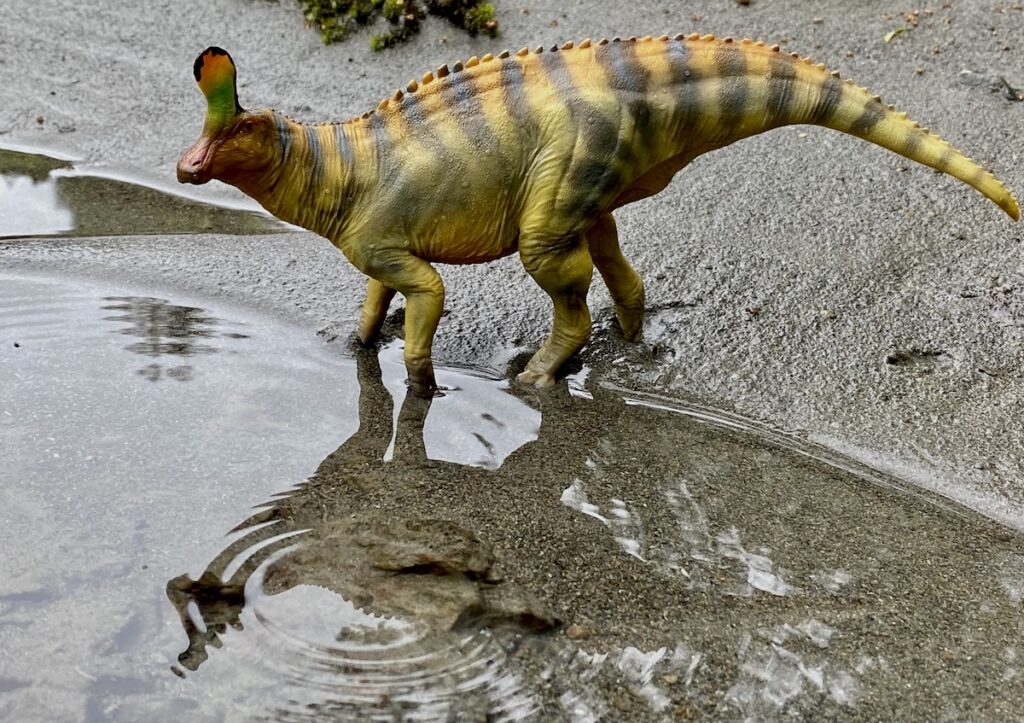
On to the legs and this is another area where you will see a big difference between this model and its hadrosaur predecessors. If you look at PNSO’s early hadrosaurs such as the Lambeosaurus, you will notice just how skinny the front legs are; so thin it looks as if it could snap the moment the animal puts any weight on it. Since then, PNSO has steadily bulked up the front legs on their hadrosaurs and we see a steady increase not only in the size but the entire musculature culminating with this Tsintaosaurus we see here today.
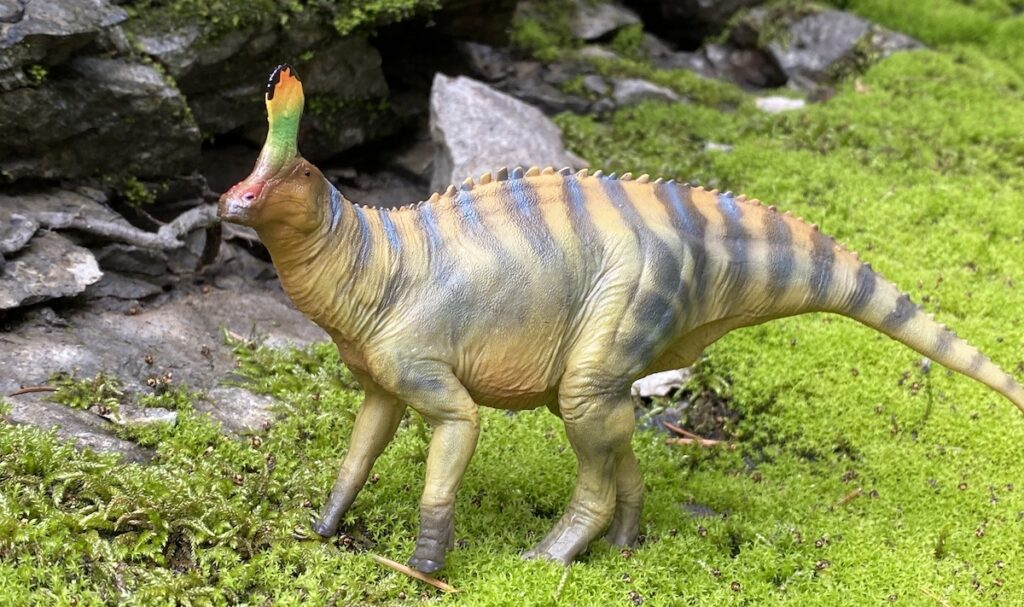
In this model, the front legs are appropriately bulked up and proportioned to the entire body. Instead of bones we now see muscles bulge as the animal put its weight on it. It’s great to see this improvement and show just how much PNSO is trying to improve with each new releases. The hoofs show that unique mitten-like shape that is known in Edmontosaurus.
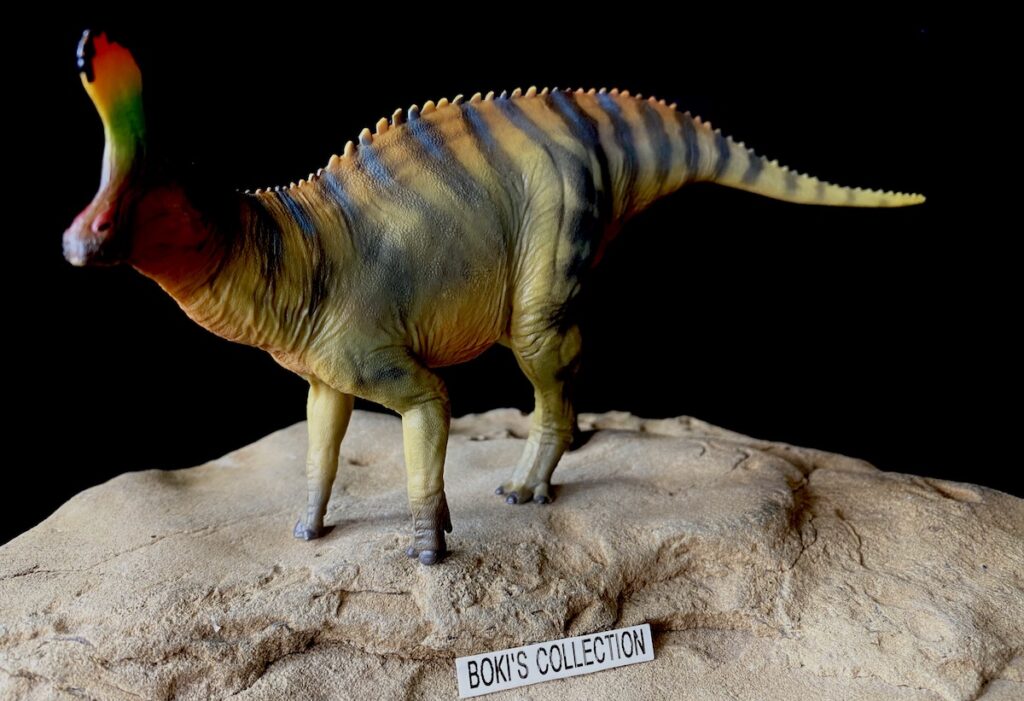
Now, it is not known if this unique front hoof shape is widespread among the various hadrosaur group or unique to Edmontosaurus. Although at this point speculative for Tsintaosaurus, its great to see PNSO incorporate such details to this new model as we currently don’t have that many figures out there that show this unique feature.
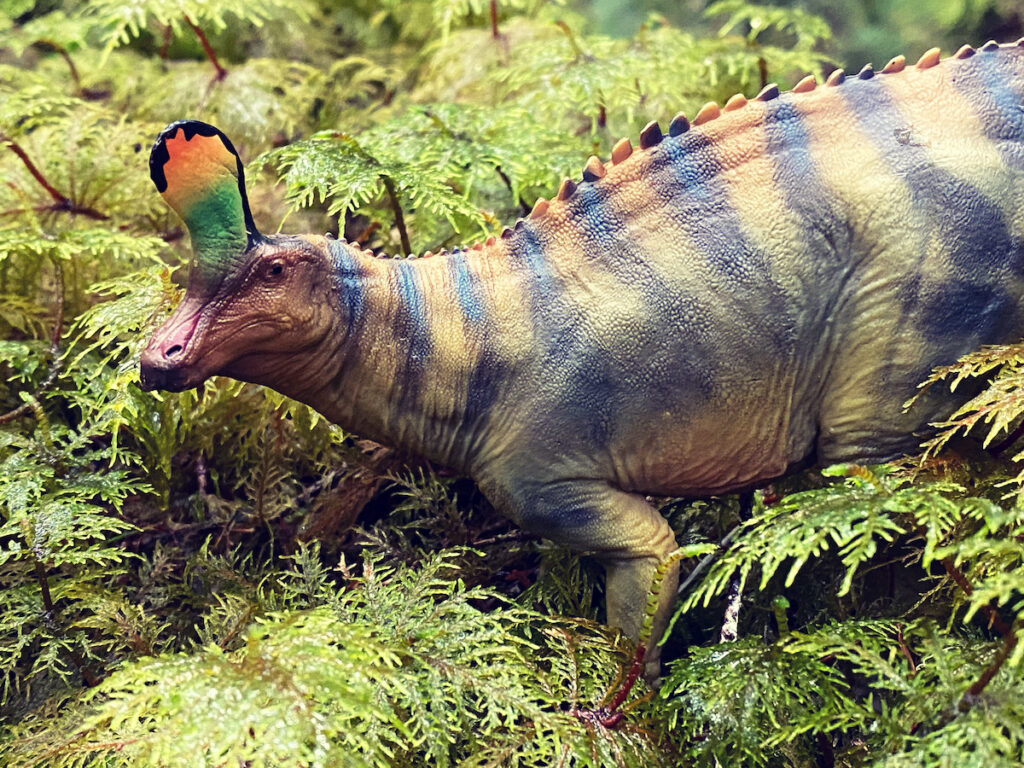
On to the colors which is special, at least if you allow yourself to really examine all the nuances and subtleties instead of just a quick glance. This mass produced version is very close to the prototype prototype photos we saw. Starting on the dorsal, we see a rich golden orange color that run the entire length of the back all the way to the tail. The richness of this color starts to dull as it moves down towards the body/flank where it then transition into a faint yellow-green before darkening to an olive green as it reaches the middle section. This dark olive green then starts to transition back to a lighter golden color as it moves down towards the belly and underside. The entire color transition is just beautifully done and so seamless that there are no hard edges between the each colors.
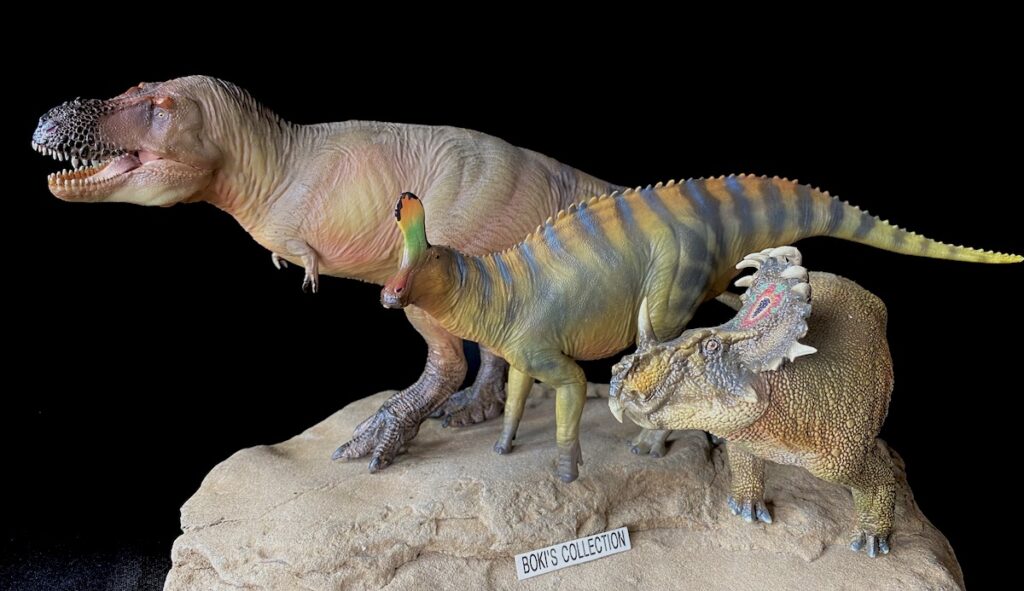
There are wide dark olive brown stripes on the back running all the way to the tail where they then form bands. These stripes are also present on the thigh as well and create nice patters that compliments the vertical dorsal stripes. Finishing off the colors, the dark stripes are given a slate blue (a difficult color to use especially on a animal as it is powerful and tend to overwhelm) stripe on the center; these are subtle and vary in its intensity depending on the light.
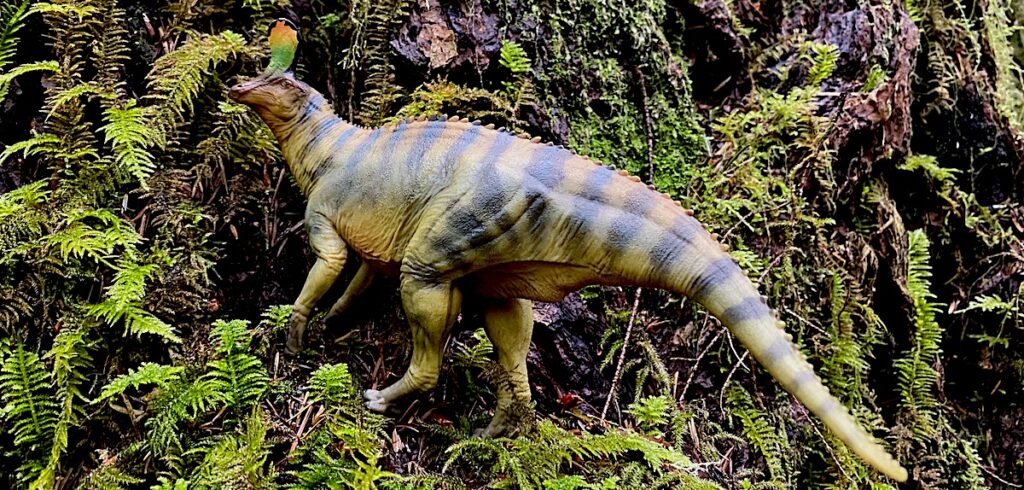
Seen under bright indirect light, the blue really pops up and almost looks neon-like! It’s a beautiful trick of lighting that is rarely captured in a pvc model, very much like what you see in some birds feather. PNSO has really mastered the art of seamless color blending that is so pleasing to the eye. The row of dorsal spines are colored in alternating gold and dark that follows the stripes.
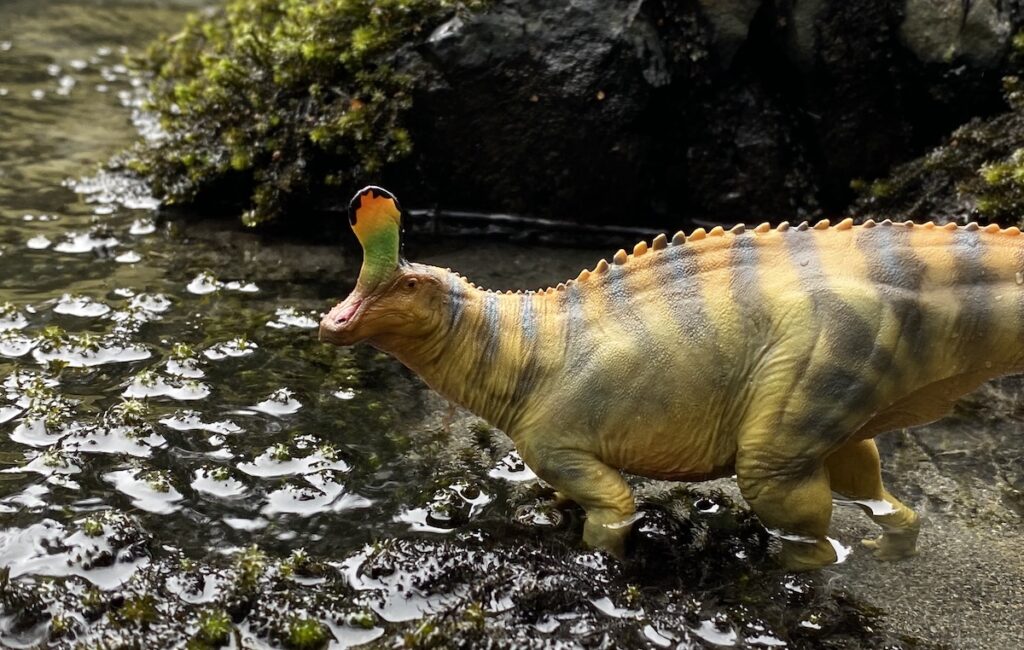
The new Museum Line concept is not everyone’s cup of tea for sure, I get that. For me personally, I find it has the potential to be a unique set but it is still relatively in its infancy, and although they seem to have settled with the additions of beautiful artwork, they are still figuring out what the right mix should be. This trend of adding visual aids to “mimic” those seen in a museum display is a novel idea but not for everyone. As much as I adore these stunning artwork add on, it’s simply not practical especially if you don’t have the space to display them. They also don’t have enough of an appeal to the wider collectors community (in fairness, this line is being promoted and seems to be specifically targeting the educators/parents and you see that throughout when you look at the content and instructions inside the booklet) and dose not fully elevate the line to match the cost when compared to the standard models.

As a Museum Line piece this model also comes with lots of artworks like booklet and posters that are beautifully reproduced. The latest addition, at least for this model, is a modern-looking base that has irregular side. It’s an odd choice since it does nothing to enhance the model or it’s presentation and it doesn’t help that on the surface there are two hole for clear rods to be inserted. This may work for the marine animals (which surely must have been the original intended use) that really requires them, but not for this model and just looks a little distracting. On the plus side, this base works perfectly for their marine reptiles like the Kronosaurus and others.

If the diorama base that was once the signature of the Museum Line is no longer an option, then I personally would like to see PNSO to go the route of adding a mini figure to each model in the line like they did with the Stegosaurus, Triceratops, and Torosaurus in addition to the artworks. These mini figure additions goes a long way in elevating the line and adding something to help justify the higher cost associated with the line.

In fact I would love to see PNSO continuing on this trend and even push it further by adding some smaller dinosaurs or animals that lived alongside the main star.Surely there are plenty of interesting options for dinosaurs and other animals that lived alongside the main star but are just so small to be made into a stand-alone 1:35 figure but would be a perfect accent piece. What better way to make these small cast of characters shine especially if the mini figures are discontinued. PNSO, if you read this, just something to think about.

Time to wrap it up, so in closing, this is one of the most beautiful hadrosaur model produced in plastic form and surely one of PNSO’s best. Although its size is a source of complaint for some, the richness of detail and vivid colors more than make up for that shortcoming and is enough to dazzle. Next to PNSO’s other beautiful hadrosaurs, it stands out despite being the smallest and would surely command attention. For the longest time hadrosaurs have been neglected and kept in the shadows, but not anymore. PNSO’s impressive herd of five is proof that these glamorous hadrosaurs deserves attention! I can’t wait to see what new additions PNSO has planned for the future.

Well, thanks for reading the review and I hope you all liked it. Until we meet again on the next one, stay safe and healthy.Cheers!
Disclaimer: links to Ebay and Amazon on the DinoToyBlog are affiliate links, so we make a small commission if you use them. Thanks for supporting us!





This was a wonderful review – as always! The photographs of the animal “in habitat” are truly a work of art. The image of the dinosaur among some mossy “ferns” and with a conifer forest in the background, is startlingly realistic and an absolutely inspired composition – just beautiful!
I do wonder however, if praise for the PNSO line in general has been a bit excessive, and that the dinosaur toy collector community needs to send PNSO a stronger message about what constitutes fair pricing. I can’t help but feel that when huge prices are charged for relatively tiny lumps of plastic, we are being gouged. Here is Australia, this Tsintaosaurus model retails for around $90.00! Sure, it’s a beautiful model, but companies like Collecta and Papo make plenty of beautiful dinosaurs too, which are equally well detailed, far larger, and a mere fraction of the price.
I brought the PNSO Machairoceratops model, and was honestly shocked by how tiny it was – it’s a beautifully detailed little model, but for the hefty price tag I expected something larger (by which I mean, at least “average” in comparison with other dinosaur toy lines). Sadly, it gets completely lost among a collection of other dinosaur figures, and you almost need a magnifying glass to admire it – it’s really disappointing that the company took this approach, presumably to save a fractional amount on their production costs and raw materials.
I could also really do without all the fancy boxing that PNSO package their Dino’s with – it doesn’t add anything at all to the model, and just seems like a shallow attempt to justify a higher price for what is, at the end of the day, just a small, mass-produced plastic dinosaur toy. The elaborate packaging and miserly size of the model leads to the absurd situation where the picture on the box art is considerably larger than the model you get to put on the shelf! It’s all very disappointing, and makes me reluctant to purchase another PNSO figure, despite their truly beautiful sculpts and fascinating subject choices… it just seems like this company has an unpleasantly predatory culture of trying to charge the highest possible price for the smallest possible model figure. That’s unlikely to make for a sustainable sales strategy in the long run!
Great review and thorough review with immersive photos as always! I hope that I’m not nitpicking too much, but Qingdao is misspelled as “Quindao.” Also, Iguanodon is not a hadrosaur.
What’s the other hadrosaur / ornithopod in the last photo?
Boki, as always, your dinosaur articles are complete and thorough. What I highlight about the tsintaosaurus (I believe the best figure of that species and one of the best in PNSO, I would dare to say that the best hadrosaurid perhaps because it is the last one) is not only what you mention, but that it is a figure without any type of sewing which is very difficult to achieve especially in PVC dinosaur toys. I also highlight the magnificent work of the crest and of the figure in general with regard to its painting, with incomparable tropical colors and only surpassed by repainting artists.
Good review, as always of course! The paint scheme and application is a joy, as are the details of the sculpt. I very much like your idea of including a small contemporary creature – that really would be superb! The base is indeed a strange choice. It looks so oddly “cheap and cheerful” – and the holes for rods flag that it must have been intended for something else originally. I use mine as a riser at the back of one of my shelves for a theropod. It’s out of sight and does the job very well. It certainly doesn’t do any favours at all the wonderful Tsintaosaurus, which is the epitome of high quality. Still, it’s only a minor grouse. I love your photo of all the hadrosaurs and the Iguanodon facing left – the way the Olorotitan seems to be breaking ranks by raising its head to see what’s going on is very funny!
Enjoyable review as always, Bokisaurus. One detail I really appreciate about your reviews is how you go into detail regarding each miniature’s actual size/scale and show it next to other figures for reference. Kudos.
One pet peeve I’ve had with multiple major prehistoric model manufacturers as of late has been their nonchalance regarding scale; one representative even replied to me that they “lied” in a jocular fashion when I inquired about the subject. Yes, it seems that manufacturers do indeed just slap a given scale on a figure sometimes regardless of its accuracy, which for a serious hobbyist can be maddening. Long gone are the days of being able to place shelves full of dinosaurs at a uniform scale (my personal preferred scale has always been 1:40, as it’s friendlier for the big sauropods that the hobby is seldom seeing anymore…a problem in its own right IMHO). I realize that for some of them perhaps they see these miniatures as toys in a sense, but most of us here take such details seriously, I believe.
In a semi-related topic, while I’m loathe to ask for yet another Spinosaurus given the glut that’s hit the hobby from every single major line over the past few years, PNSO’s scaling of their last (not the repainted one with the base) Spino was probably the best and most accurate out there, but was horribly mis-scaled and WAY undersized for displaying alongside my other 1:40 theropods. This year’s CollectA model would be right in the Goldilocks zone if it just didn’t have those broken-looking front wrists. If/when PNSO ever makes another Spino update, I really hope it A) is bleeding-edge accurate and B) scales perfectly with the new Wilson and other theropods in their line.
Thanks for hearing me out. And again, great review.